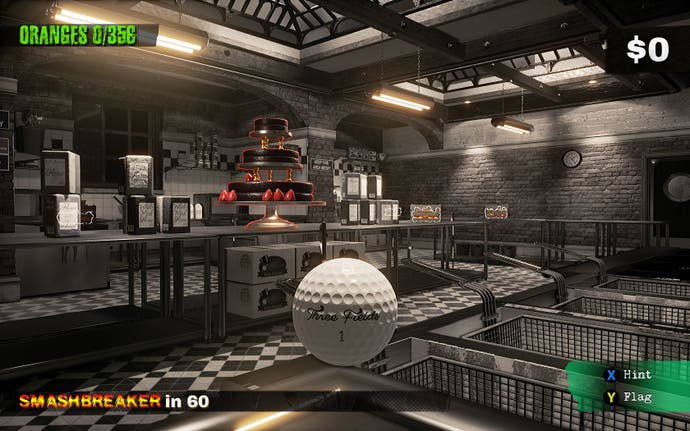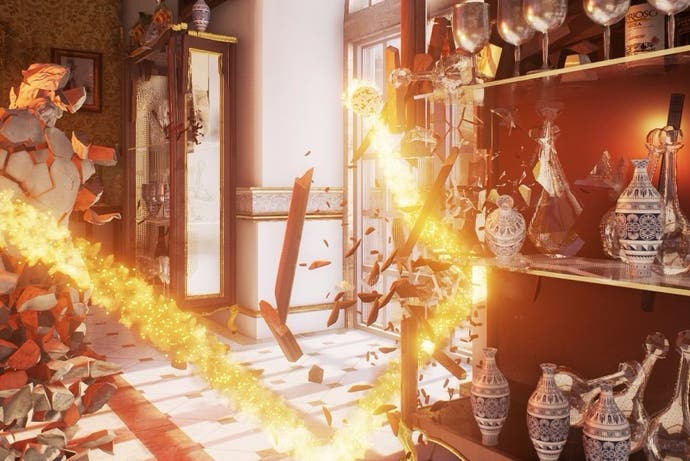Dangerous Golf's new patch does wonders for this unusual gem
Quick restarts, simplified controls and the return of a Burnout legend.
Dangerous Golf has been fixed, and I will argue that from the slightly awkward position of someone who never thought it was broken in the first place. No. Let's try it a different way. How about this? I suspect that there has never been a better time to try out this strange, wilful, explosive and frequently beautiful twist on golf than tomorrow, when an update patch goes live with a range of tweaks that significantly change the pace and texture of the game.
To understand Dangerous Golf in the first place, don't think of green grass and Tiger Woods and that BBC commentator who's often amazingly sexist. Think about a phrase I heard this morning in the Three Fields office when I was being shown the build that's being released tonight - the phrase the design team uses when describing the appeal of its game.
We were talking about the best means of destroying a piano at the time, and designer Chris Roberts explained that the way that the Dangerous Golf team tends to pick its targets is by thinking about "naughty destruction". This is a less a game about sinking putts as it is about bashing up stuff that you feel a little bit guilty about bashing up: oil paintings, suits of armour, wine cellars, KitchenAids.
This explains why the new patch's stand-out feature initially seemed such a big ask. Dangerous Golf's levels are crammed with physics objects. Hundred of them: oranges to splat on walls, paint tins to upend, glass to break, bookcases and vases to shatter. Because of this, restarts in the game as it originally released took between 25 and 30 seconds. "Every one of those objects has to be unsmashed and put back together again," says Paul Ross, who's been programming games since TrickStyle. "There's the splats to get off the walls. The flag in the hole may have burned down."
The traditional way to do a reset, Ross explains, is to simply scrap everything and reload the level from the disk. But that takes too long. "What we do now is more like sending in the cleaners," he explains. Every object is returned to its original state and its original position. Astonishingly, restarts now take around two seconds. And at no loss of level complexity.

It has an extraordinary effect on the game. Dangerous Golf has always been playful in its destructiveness, but now it's far easier to approach it in a whimsical, experimental manner. You can take a risk on an unusual tee-off. You can hit hard and hope, knowing that you're only seconds from a do-over anyway.
And working in tandem with fast reloads are a range of other changes, starting with an overhaul of the controls. The original set-up will remain in place for people who are used to them, but there's a new option in the form of a simplified method. Steering the ball in Smashbreaker mode, for example, can now be a single-stick affair, ditching the Warthog controls that require you to move the camera with one stick and push forward with the other. Equally, triggering Smashbreakers now takes a single button press, as does dropping the ball to the floor on cue - a change that came about as players were accidentally pulling off the dual-trigger-grab drop by accident while trying to alter the ball's bounciness. Elsewhere, a new follow-cam can track the ball during both your final putt and your initial shot (you can even slow time down straight off the tee), and on both occasions you can rotate the camera a full 360 degrees for a wider aim before you shoot.
Best of all, I think, is the Smashwave, a sort of last ditch effort to create a final bit of chaos. Once your Smashbreaker has run its course and your ball drops to the floor, you can trigger a final explosion, complete with a radiating shockwave, that takes out any nearby clutter without moving the ball's position. "There's a bit of risk and reward in everything we do," says Roberts. "You can get a lot of extra points with Smashwave, but you've still got to putt-in, and you risk bringing a huge piece of furniture down on top of yourself."
Taken as a whole, the new patch knocks a lot of the rough edges off Three Fields' debut, while crucially losing none of the focus that makes Dangerous Golf such a delight to play. This is still a wonderful nihilistic treat, paving a way for the use of physics and simulation in games with every broken plate and every shattered champagne bottle. There's still no unnecessary UI and screen clutter, no pointless story stitching every room-sized piece of destruction together, and no prompt system cueing you in, Ubisoft-style, to the game's most devious secrets.
And there's more, too. From tiny tweaks like the inclusion of a sound effect when you hit the game's Roman statues in the groin - every player seems to make this a priority, it turns out, and the audio use in the toilet level had already earned the team a "Comic Mischief" rating from the ESRB, so they decided to double down on it - to handy prompts that make it much easier to sink balls into buckets if you're going for the really big scores.
And there's one final major addition, that, as a Burnout fan, perhaps pleases me the most. Dangerous Golf, for all its immediacy, could still drop you in at the deep end when you first fired it up. Now there's a video tutorial at the start that explains a few of the game's more nuanced elements. And who's it voiced by? DJ Stryker, last heard - outside of KROQ - on Burnout 3: Takedown. How perfect is that? Dangerous Golf is truly coming home.


